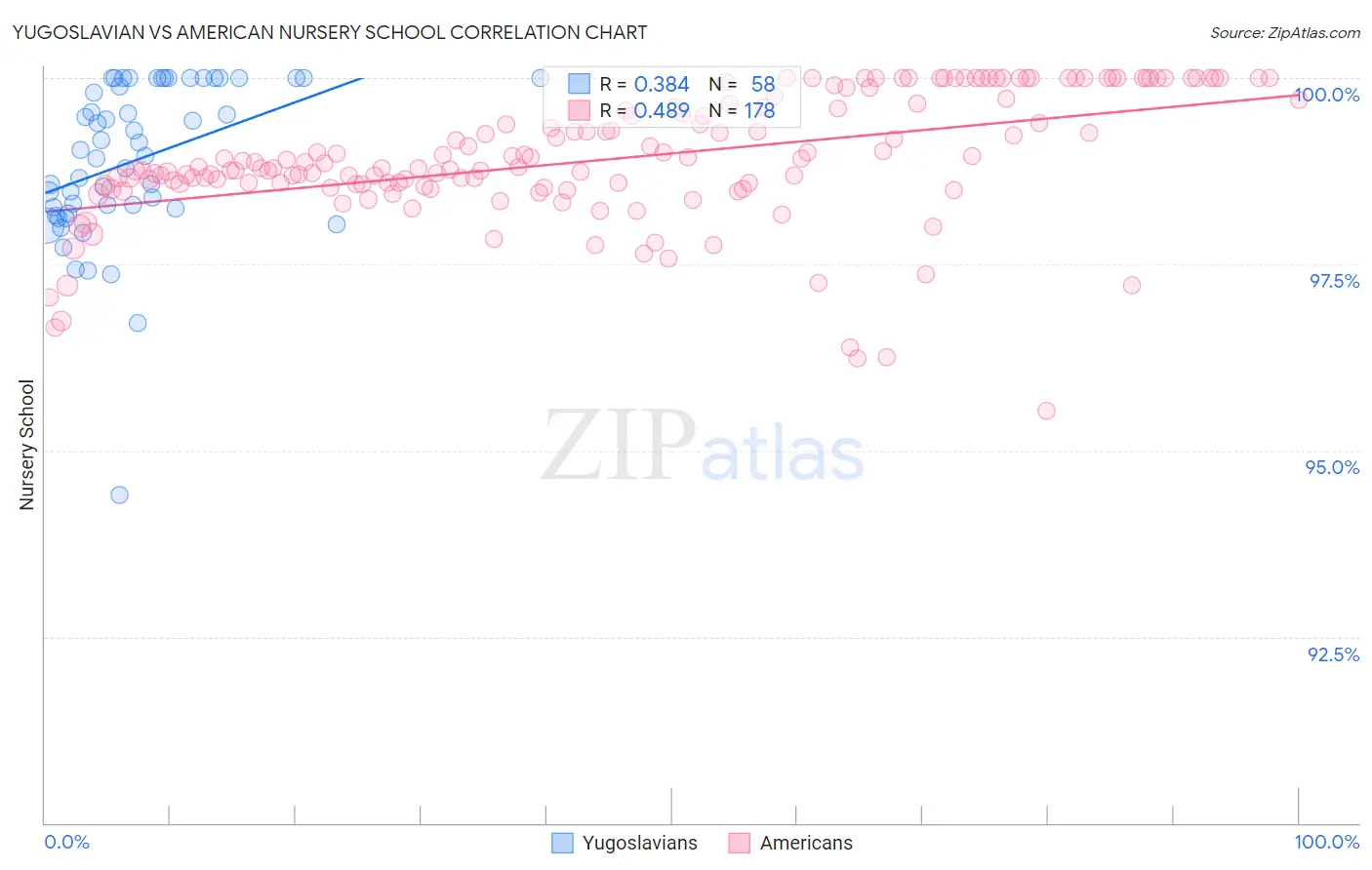Yugoslavian vs American Nursery School
COMPARE
Yugoslavian
American
Nursery School
Nursery School Comparison
Yugoslavians
Americans
98.2%
NURSERY SCHOOL
95.4/ 100
METRIC RATING
118th/ 347
METRIC RANK
98.4%
NURSERY SCHOOL
99.8/ 100
METRIC RATING
56th/ 347
METRIC RANK
Yugoslavian vs American Nursery School Correlation Chart
The statistical analysis conducted on geographies consisting of 285,681,276 people shows a mild positive correlation between the proportion of Yugoslavians and percentage of population with at least nursery school education in the United States with a correlation coefficient (R) of 0.384 and weighted average of 98.2%. Similarly, the statistical analysis conducted on geographies consisting of 581,989,447 people shows a moderate positive correlation between the proportion of Americans and percentage of population with at least nursery school education in the United States with a correlation coefficient (R) of 0.489 and weighted average of 98.4%, a difference of 0.23%.

Nursery School Correlation Summary
| Measurement | Yugoslavian | American |
| Minimum | 94.4% | 95.5% |
| Maximum | 100.0% | 100.0% |
| Range | 5.6% | 4.5% |
| Mean | 98.9% | 98.9% |
| Median | 99.0% | 98.8% |
| Interquartile 25% (IQ1) | 98.2% | 98.6% |
| Interquartile 75% (IQ3) | 100.0% | 99.7% |
| Interquartile Range (IQR) | 1.8% | 1.1% |
| Standard Deviation (Sample) | 1.1% | 0.87% |
| Standard Deviation (Population) | 1.1% | 0.86% |
Similar Demographics by Nursery School
Demographics Similar to Yugoslavians by Nursery School
In terms of nursery school, the demographic groups most similar to Yugoslavians are Immigrants from France (98.2%, a difference of 0.0%), Spanish (98.2%, a difference of 0.010%), Thai (98.2%, a difference of 0.010%), Okinawan (98.2%, a difference of 0.010%), and Immigrants from Norway (98.2%, a difference of 0.020%).
| Demographics | Rating | Rank | Nursery School |
| Immigrants | Czechoslovakia | 96.8 /100 | #111 | Exceptional 98.2% |
| Immigrants | Norway | 96.6 /100 | #112 | Exceptional 98.2% |
| Immigrants | Latvia | 96.4 /100 | #113 | Exceptional 98.2% |
| Ute | 96.4 /100 | #114 | Exceptional 98.2% |
| Iranians | 96.3 /100 | #115 | Exceptional 98.2% |
| Spanish | 95.8 /100 | #116 | Exceptional 98.2% |
| Immigrants | France | 95.6 /100 | #117 | Exceptional 98.2% |
| Yugoslavians | 95.4 /100 | #118 | Exceptional 98.2% |
| Thais | 95.0 /100 | #119 | Exceptional 98.2% |
| Okinawans | 94.5 /100 | #120 | Exceptional 98.2% |
| Immigrants | Zimbabwe | 94.2 /100 | #121 | Exceptional 98.2% |
| Immigrants | Japan | 94.0 /100 | #122 | Exceptional 98.2% |
| Syrians | 93.9 /100 | #123 | Exceptional 98.2% |
| Lebanese | 93.8 /100 | #124 | Exceptional 98.2% |
| Iroquois | 93.7 /100 | #125 | Exceptional 98.2% |
Demographics Similar to Americans by Nursery School
In terms of nursery school, the demographic groups most similar to Americans are Austrian (98.4%, a difference of 0.0%), Bulgarian (98.4%, a difference of 0.0%), Kiowa (98.4%, a difference of 0.010%), Pueblo (98.4%, a difference of 0.010%), and Immigrants from Scotland (98.4%, a difference of 0.010%).
| Demographics | Rating | Rank | Nursery School |
| Whites/Caucasians | 99.8 /100 | #49 | Exceptional 98.5% |
| Celtics | 99.8 /100 | #50 | Exceptional 98.5% |
| Estonians | 99.8 /100 | #51 | Exceptional 98.5% |
| Australians | 99.8 /100 | #52 | Exceptional 98.5% |
| Kiowa | 99.8 /100 | #53 | Exceptional 98.4% |
| Pueblo | 99.8 /100 | #54 | Exceptional 98.4% |
| Immigrants | Scotland | 99.8 /100 | #55 | Exceptional 98.4% |
| Americans | 99.8 /100 | #56 | Exceptional 98.4% |
| Austrians | 99.8 /100 | #57 | Exceptional 98.4% |
| Bulgarians | 99.8 /100 | #58 | Exceptional 98.4% |
| Immigrants | Canada | 99.8 /100 | #59 | Exceptional 98.4% |
| Slavs | 99.8 /100 | #60 | Exceptional 98.4% |
| New Zealanders | 99.7 /100 | #61 | Exceptional 98.4% |
| Creek | 99.7 /100 | #62 | Exceptional 98.4% |
| Immigrants | North America | 99.7 /100 | #63 | Exceptional 98.4% |